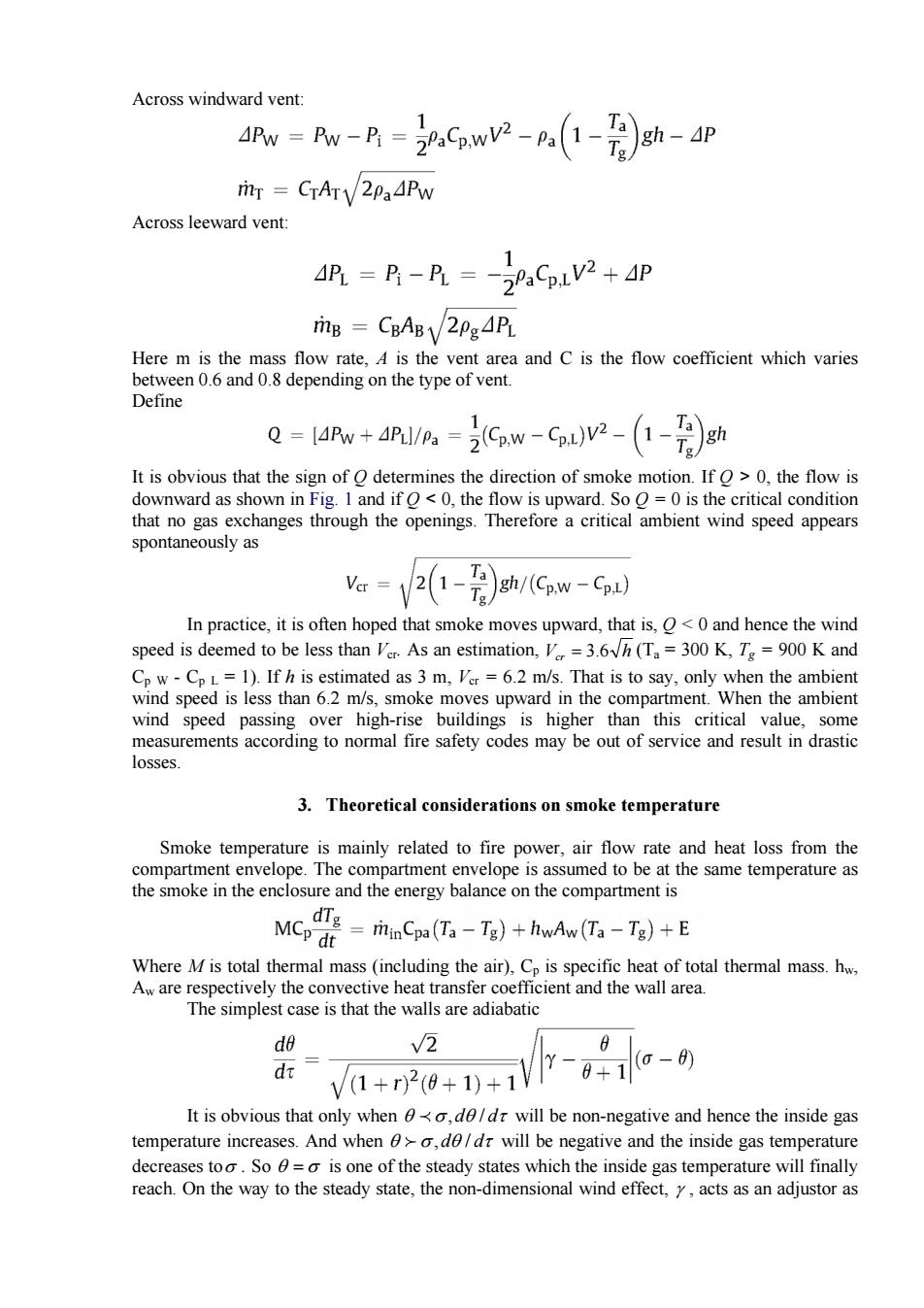正在加载图片...

Across windward vent: aPW=w2Cwv2-Pa(1-)sh-dP rt =CTATV2pa4Pw Across leeward vent: 1 4R=R-R=20a91V2+4P ring=CBABV2pgAPL Here m is the mass flow rate,A is the vent area and C is the flow coefficient which varies between 0.6 and 0.8 depending on the type of vent. Define -ldPw+lw-Cpu)v2-(1-gh It is obvious that the sign of determines the direction of smoke motion.If>0,the flow is downward as shown in Fig.I and if <0,the flow is upward.So =0 is the critical condition that no gas exchanges through the openings.Therefore a critical ambient wind speed appears spontaneously as a=V2(-w- In practice,it is often hoped that smoke moves upward,that is,<0and hence the wind speed is deemed to be less than Vr As an estimation,V=3.h(T=300K,T=900K and Cp w-CpL=1).If h is estimated as 3 m,Ver =6.2 m/s.That is to say,only when the ambient wind speed is less than 6.2 m/s,smoke moves upward in the compartment.When the ambient wind speed passing over high-rise buildings is higher than this critical value,some neasurements according to normal nire satety codes may be out or service and result in drastie 3.Theoretical considerations on smoke temperature wer air flow rate and heat loss from the nent envel is assumed to be at the same temperature as =ritin Cpa (Ta -Tg)+hwAw(Ta-Tg)+E Where M is total thermal mass (including the air),Cp is specific heat of total thermal mass.hw, Aw are respectively the convective heat transter coefficient and the wall area. The simplest case is that the walls are adiabatic de d va+00-D+1V-0-1G-0 It is obvious that only whend/dr will be non-negative and hence the inside gas temperature increases.And when >o,de/dr will be negative and the inside gas temperature decreases too.So=is one of the steady states which the inside gas temperature will finally reach.On the way to the steady state,the non-dimensional wind effect,y,acts as an adjustor as Across windward vent: Across leeward vent: Here m is the mass flow rate, A is the vent area and C is the flow coefficient which varies between 0.6 and 0.8 depending on the type of vent. Define It is obvious that the sign of Q determines the direction of smoke motion. If Q > 0, the flow is downward as shown in Fig. 1 and if Q < 0, the flow is upward. So Q = 0 is the critical condition that no gas exchanges through the openings. Therefore a critical ambient wind speed appears spontaneously as In practice, it is often hoped that smoke moves upward, that is, Q < 0 and hence the wind speed is deemed to be less than Vcr. As an estimation, Vcr 3.6 h (Ta = 300 K, Tg = 900 K and Cp W - Cp L = 1). If h is estimated as 3 m, Vcr = 6.2 m/s. That is to say, only when the ambient wind speed is less than 6.2 m/s, smoke moves upward in the compartment. When the ambient wind speed passing over high-rise buildings is higher than this critical value, some measurements according to normal fire safety codes may be out of service and result in drastic losses. 3. Theoretical considerations on smoke temperature Smoke temperature is mainly related to fire power, air flow rate and heat loss from the compartment envelope. The compartment envelope is assumed to be at the same temperature as the smoke in the enclosure and the energy balance on the compartment is Where M is total thermal mass (including the air), Cp is specific heat of total thermal mass. hw, Aw are respectively the convective heat transfer coefficient and the wall area. The simplest case is that the walls are adiabatic It is obvious that only when , d / d will be non-negative and hence the inside gas temperature increases. And when , d / d will be negative and the inside gas temperature decreases to . So is one of the steady states which the inside gas temperature will finally reach. On the way to the steady state, the non-dimensional wind effect, , acts as an adjustor as